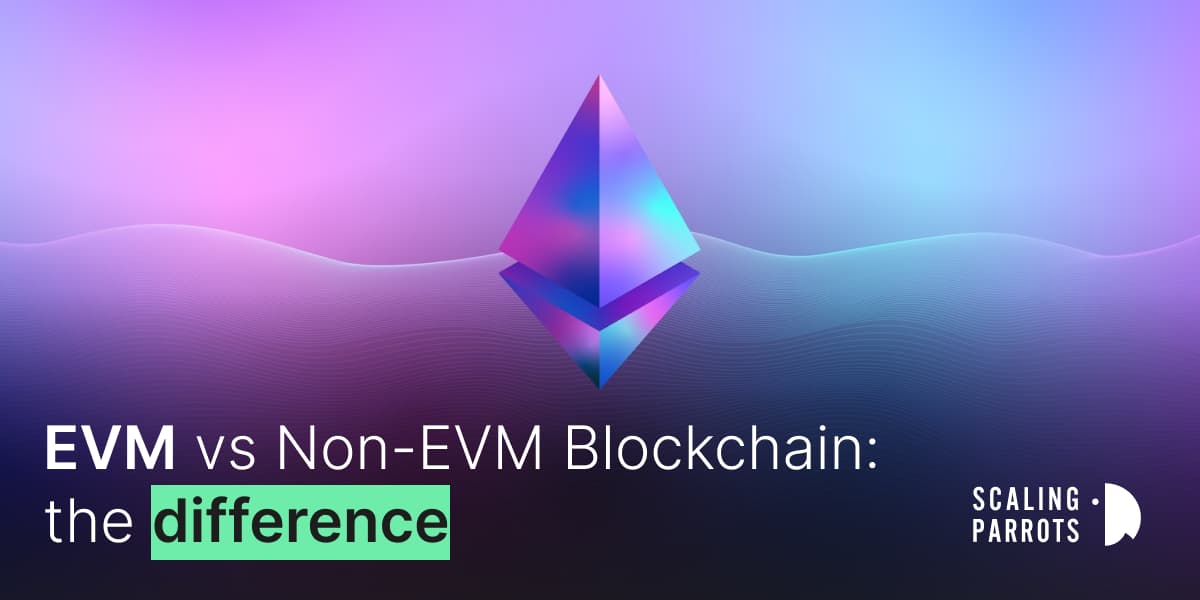
Despite the frequent confusion between the terms Ether and Ethereum, they are not identical. The cryptocurrency is called Ether, and the network is called Ethereum.
Like the majority of cryptocurrencies, Ethereum is a Blockchain as well as a digital asset. The Ethereum network is a Blockchain created specifically to work with smart contracts.
Smart contracts allow programmers to create applications for a number of uses, including the use of decentralized applications. And the Ethereum Virtual Machine (EVM) makes this possible.
But what is Ethereum Virtual Machine, and how does it works? This article will answer that question and distinguish between Ethereum Virtual Machine and Non-Ethereum Virtual Machine while discussing their purpose, advantages and disadvantages and the best solution.
What are EVM and Non-EVM Blockchain
A virtual machine (VM) is a program that simulates the operation of a computer. You’ll often see abstract definitions of a virtual machine as a “system,” “mechanism,” or “software platform,” but it’s really just a program that you install and run.
A virtual machine (VM) emulates another computer. It has its own memory and storage space and a CPU. You can run various programs on it, create files, and so on – except that this machine does not exist physically.
Because of all the buzz surrounding the Ethereum Virtual Machine, many people believe it is a Blockchain-specific technology, but it is not.
In fact, if you’re a Mac user, you’re probably more familiar with virtual machines than you realize. Have you ever used Parallels, VMWare, or another software to run Windows applications on your Mac? These are, in fact, virtual machines!
The Ethereum Virtual Machine, or EVM, was the first virtual machine created for the Blockchain industry. It is an abstraction layer between a physical machine (a node) and the smart contract code.
Every Ethereum node runs an instance of the EVM, and they all work together to form a sort of web or global decentralized computer. Ethereum is even referred to as a “world computer”, as stated by Vitalik Buterin.

Crediti: Wikipedia
The Ethereum Virtual Machine (EVM) is the Ethereum network’s heart and soul. It is also the platform for smart contract deployment and execution.
The physical manifestation of the EVM cannot be compared to a cloud or an ocean wave. Still, it does exist as a single unit maintained by thousands of linked computers running an Ethereum client.
Ethereum Virtual Machine is a software platform used by developers to create decentralized applications (dApps) on Ethereum. All Ethereum accounts and smart contracts exist on this virtual machine.
Other Blockchains have chosen a different path than EVM compatibility and are referred to as the Non-EVM Blockchain.
However, not being EVM-compatible can be advantageous and disadvantageous. Notably, given its low fees and speed, Algorand, built on EVM Blockchain, had the potential to be a thriving DeFi ecosystem. However, Algorand has only had two dApps deployed so far.
Despite this, it is clear that non-EVM chains have more room for innovation because Ethereum’s limitations do not apply to them.
The EVM’s job is to add a few extra functionalities to the Blockchain so that users of the distributed ledger encounter fewer problems. Each Ethereum node uses the EVM to maintain Blockchain consensus.
EVM performs all kinds of tasks on the Blockchain, like a massive decentralized or master computer.
The EVM is a straightforward stack-based execution machine that carries out bytecode instructions to change the state of a system, and it can only use gas to carry out instructions.
This system prevents infinite loops that could lead to denial of service attacks. The runtime environment of the Ethereum Virtual Machine is totally isolated. There is no external resource access for code running inside the EVM.
As a result, the Ethereum Blockchain has increased security, deterministic execution, and support for untrusted code.
The EVM is Turing complete, which means it will find an answer if asked. Users can create smart contracts in Ethereum’s programming language, Solidity, and send them to the EVM for interpretation and execution. The Ethereum protocol serves as the contract’s consensus architecture.
How does EVM work
EVM is quickly becoming an enterprise standard and the connecting thread between Blockchains. Even the most ardent opponents of EVM have invested in it because it is the new onramp channel for users, assets, and liquidity, adding developer experience, efficiency, and lower costs.
EVM chains may continue to grow as more businesses adopt Web3. Enterprises require stability, scalability, interoperability, and security, and EVM-compatible projects currently provide these.
EVM’s objective is to ascertain what Ethereum’s overall state will be for each block in the Blockchain.
Like other Blockchain-based networks, Ethereum uses a distributed ledger to record transactions and has its own native cryptocurrency (ETH). Still, it also imposes restrictions on how users can interact with the network.
On the other hand, Ethereum provides a further layer of functionality because of its smart contract capabilities. The second layer has the name “distributed state machine.”
In addition, the Ethereum state is a machine state that can modify each new block and run any machine code per a predetermined set of guidelines.
The specific guidelines governing how the machine will change state during each new block being added are defined by the Ethereum virtual machine.
The Ethereum system’s consensus engine and a crucial part of the Ethereum protocol are the EVM.
Anyone can run code in a system without a central trust, and the outcome of the execution can be guaranteed and is known in advance.
Each instruction used in the EVM is given a cost in gas units by a system that keeps track of execution costs.
What is the purpose of EVM and Non-EVM in Blockchain
The EVM’s function is to determine and keep track of each network block’s status. Although it may sound like a surveillance tool, it actually refers to state changes, which are signals or causes of actions in various computer systems.
A change of state occurs, for instance, when something is turned on or off, activated or deactivated, sent or received, or when a file or document is moved.
These changes in the state generate modifications in the data structure of the computational systems.
The EVM can review changes in the state of the network and the dApps so that Ethereum and the software mounted on it work in a decentralized way, taking into account issues such as network saturation or operation priorities.
In this way, the EVM allows any developer to run code within an ecosystem that does not need to be based on trust in third parties and where the execution of the software and the result of the interactions are guaranteed and predictable.
What are the differences between EVM and Non-EVM Blockchain
Unlike Ethereum Virtual Machine, Non-EVM chains have more room for innovation.
Raydium and Serum, for example, are unique to the Solana chain. Terra, on the other hand, is an exclusive public chain that connects on-chain and off-chain payments.
Currently, 80% of the top ten chains are EVM-compatible, and non-EVM chains such as Terra and Solana are developing EVM-compatible solutions or can already operate with Ethereum’s account system (NEAR’s Aurora, Solana’s Neon, Polkadot’s Moonbeam, and so on).
Although Ethereum remains the market leader among public chains, its market share has fallen from 72.87% to 61.19% in the last six months, a drop of more than 10% in absolute terms. Emerging chains are rapidly outgrowing Ethereum.
Ethereum is the most active chain for DeFi projects and users and a hub for cutting-edge projects such as NFT ecosystems.
Attracting Ethereum traffic is the quickest way for new chains to grow, and EVM compatibility is the most convenient solution. Developers can quickly “copy and paste” contracts from Ethereum to other chains in this manner.

What is the best solution? EVM Blockchain or Non-EVM Blockchain
For a long time, there has been a debate between EVM and non-EVM chains. Although it appears that EVM virtual machines are the clear winners, non-EVM chains such as Solana make the fight worth watching. EVM compatibility is the primary requirement for evaluating a public chain platform.
Non-EVM-compatible chains, on the other hand, are more likely to develop in emerging categories and niches. Diverse public chains can thrive in industries like NFTs, GameFi, and payments.
With the benefits of Ethereum, EVM-compatible public chains can quickly gain customers and grow in the early stages. They must, however, compete with many other chains in the Ethereum ecosystem. As a result, they will benefit in terms of developer friendliness, user experience, and ecosystem incentives.
Non-EVM-compatible chains are more likely to grow in trending categories and niches with new ideas. Innovation can be successful in the DeFi market with their application scenarios.
It’s impossible to say whether EVM or non-EVM chains are better overall. Instead, each case is unique, and developers must select a public chain that corresponds to the development path of their project.
It is more critical for DeFi users to evaluate the project’s potential from a different perspective based on the model.
Now let us examine each of their advantages and disadvantages to comprehend the actual scenario in Ethereum Virtual Machine vs Non-Ethereum Virtual Machine.
Advantages and disadvantages of EVM and Non-EVM Blockchain
Advantages of EVM
- Since EVM enables anyone to develop a decentralized application, there are no security obstacles or limitations.
- If you are familiar with NFTs, or non-fungible tokens, they are made with the aid of an EVM and have recently become very popular in the cryptocurrency market. Digital art can be created by anyone and sold on a decentralized market. This makes previously inaccessible virtual access to the art market more accessible.
- Scalability and migration of EVM from the Ether ecosystem are simple. Project access is made simpler for users here. The goal of every project is to increase transaction speed and add multi-chain functionality, among other things. For instance, NEAR launched Aurora, and Polkadot added Moonbeam.

Disadvantages of EVM
- Although decentralized, the EVM network is not entirely decentralized. The vast majority of Amazon Web Services centralized cloud servers are used to host Ethereum nodes. The nodes might just be rejected if the operators of these services decide they don’t like Ethereum for whatever reason, which would hurt the network.
- EVM calls for some technical know-how. Therefore, it is restricted to those without coding knowledge. More user-friendly interfaces are still being developed. Once more, graphical user interface (GUI) applications enable almost anyone to create NFTs and utilize related markets.
- Costs for gas are high when networks are congested. This might be a serious drawback for Ethereum users. Although those sending large transactions might not be impacted, those sending smaller transactions might experience network access issues for a while. For decentralized applications, this presents particular difficulties. When many users interact with DApp smart contracts and carry out numerous transactions, things may sluggishly or even cease functioning if fuel prices rise too high.
- Due to the rigidity of its bytecode language and native functionality, EVM is too complex and does not have enough virtual machine features to be safe by design. Furthermore, it is less innovative due to Ethereum and EVM rules. Language designers are forced to manually implement many features and essential parts of the execution model of the EVM.
Advantages of Non-EVM Blockchain
- Non-EVM enables programmers to broaden their user bases and applications. For instance, the Solana chain’s projects, Raydium and Serum, are exclusive to Solana. On the other hand, Terra is a distinctive public chain that aims to link on-chain and off-chain payments. Additionally, platforms that are incompatible with EVM can provide end users with quick transaction times and inexpensive transactions.
Disadvantages of Non-EVM Blockchain
- Chains that are incompatible with EVM have drawbacks like high developer costs, high entry barriers, challenging project migration, etc. Because non-EVM compatible chains have a clear disadvantage in terms of project count, developers prefer chains that are EVM compatible so they can quickly replicate and deploy to new chains.
Conclusion
So, who won the war between EVM chains and non-EVM chains? Neither can be definitively chosen over the other. Each case is unique, and developers must select a public chain that corresponds to the development path of their project.
EVM Blockchain can assist developers in driving traffic acquisition and ecosystem growth. This is because Ethereum users can quickly migrate to new chains. Meanwhile, non-EVM Blockchain will almost certainly allow developers to experiment.
See you soon,
Scaling Parrots
